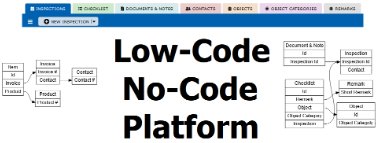Low-Code/No-Code Development Platforms
Software development is an intricate process that requires a high level of technical expertise, time, and resources. However, with the emergence of Low-Code/No-Code Development Platforms, creating software has become easier and more accessible to non-technical users. These platforms enable users to build applications without writing complex code, which means that businesses can create software solutions faster, more efficiently, and at a lower cost. In this article, we will explore the world of Low-Code/No-Code Development Platforms, their benefits, limitations, and future prospects.

What are Low-Code/No-Code Development Platforms?
Low-Code/No-Code Development Platforms are software tools that enable users to create applications without having to write code. These platforms provide a visual interface that allows users to drag and drop components to create applications. The low-code platforms offer a certain level of customization and flexibility, allowing users to modify the code if needed. On the other hand, no-code platforms are more restrictive, and users can only use pre-built components.
Low-code and no-code tools are designed to simplify the application development process by allowing users to create custom applications without having to write extensive code. Here’s how these tools work:
- Visual Interface: Low-code and no-code platforms use visual interfaces that allow users to create applications through drag-and-drop actions. This means that users can simply select the required elements and place them onto the application interface.
- Pre-built components: Low-code and no-code tools typically come with pre-built components that users can use to create their applications. These components include forms, tables, charts, and various other user interface elements. These pre-built components make it easy for users to build applications without requiring extensive coding knowledge.
- Configurable options: Once the basic elements of the application have been added, users can customize these elements using configurable options. This allows them to set parameters such as colors, fonts, and other design elements.
- Integration with databases and APIs: Low-code and no-code tools typically integrate with databases and APIs, allowing users to easily connect their applications to various data sources. This makes it easy to create applications that can read, write, and manipulate data.
- Code generation: Some low-code tools generate code automatically in the background, based on the actions taken by the user. This can be useful when users need to perform more complex actions that cannot be achieved through drag-and-drop actions.
- Testing and deployment: Once the application has been built, low-code and no-code platforms provide users with tools to test and deploy their applications. This allows them to ensure that the application works as expected and is ready for use.
Overall, low-code and no-code tools simplify the application development process by providing users with pre-built components, visual interfaces, and configurable options. This makes it easy for anyone to create custom applications without requiring extensive coding knowledge.
Benefits of Low Code/No Code Development Platforms:
Faster Development Time: Low-code/no-code platforms enable users to create applications in a fraction of the time it would take to write the code manually.
Lower Costs: By eliminating the need for expensive developers, businesses can save money on software development costs.
Ease of Use: Low-code/no-code platforms offer a user-friendly interface, making it easy for non-technical users to create applications.
Scalability: These platforms enable businesses to scale their applications quickly and efficiently, making it easy to add new features and functionalities.
Increased Agility: With the ability to make changes to the application quickly and easily, businesses can respond faster to changes in the market.
Limitations of Low-Code/No-Code Development Platforms:
- Limited Customization: No-code platforms are more restrictive, limiting the customization options available to users.
- Security Concerns: Since these platforms are user-friendly, there is a higher risk of data breaches and security vulnerabilities.
- Integration: Integration with legacy systems or third-party tools can be challenging, limiting the platform’s flexibility.
- Technical Limitations: These platforms are not suitable for developing complex applications that require advanced functionalities.
- Vendor Lock-in: Since these platforms are proprietary, businesses may face vendor lock-in, making it difficult to switch to another platform.
Source: Satish Prasad (rpabotsworld)
What's Your Reaction?

















